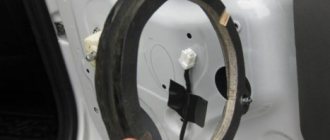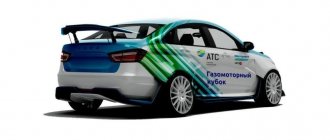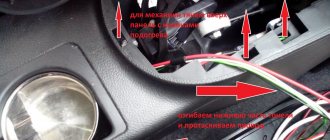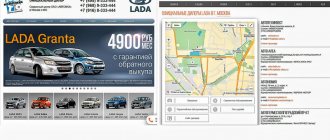Lada Vesta, like other thoroughbred offspring of the domestic automobile industry, usually has no indifferent people. Either they love her and praise her in every possible way, or, on the contrary, they fiercely hate her and carefully look out for all the “jambs”. And no matter how enthusiastic owners come to the defense of any car with arguments like “for that kind of money it’s stupid to expect premium class quality.” If you talk to car owners, you can identify several traditional problems. But it is worth noting that they are typical for early versions of the machine.
The first thing that can not only upset, but also quite frighten the owner of a Vesta is the appearance of severe scratches on the glass . Many motorists have noticed that as soon as they start rolling down the windows, a grinding sound is heard, after which they appear scratched before the driver. The reason lies in the fact that the elastic bands are far from elastic, but oak, as if made of plastic. Naturally, they will scratch the glass. At the same time, in cars where there is a soft “velvet” strip in this place, the problem persists. They press quite strongly against the glass, and when wet, dirt can stick to their surface, which scratches the glass.
Of course, in this case it is obvious that the problem is with the developers, but under warranty they will not change or fix anything for you. Because from 2020 this is not included in the warranty cases. The manufacturer claims that all these rubs and scratches appear due to the fault of the driver who closes the dirty windows.
The attributes of horror films in the domestic car do not end there. Many motorists notice strange knocks and squeaks while driving. Judging by the owners, such sounds may be caused by stabilizer struts that need to be replaced.
As can be seen from the complaints of “Vestovodov”, the car is also slightly at odds with modern technologies . For example, you can often encounter a situation where you drive from point “A” to point “B” to music or an audiobook, but back in complete silence. Because the multimedia complex may outright refuse to work. Experienced drivers of this miracle of automotive technology carry with them a paper clip, which they use to press the system reset button to reanimate the device.
The rear view camera is also not without its sins. She may easily refuse to show you the “rear”, showing you a black screen. The service provider promised someone who encountered such a problem that after reflashing the problem would be corrected. And the driver himself, through experimentation, realized that the problem was in the AUX. If you select it and then return to the other inputs, the camera will make a similar display.
With prolonged use, the automatic . Many people notice that it jerks during climbs and during smooth starts. However, AVTOVAZ states that this is only an isolated case, that there is no difference whether the gearbox is automatic or manual - the design of the clutch discs is the same. The company also says that it is developing a new design that will be smoother due to the new material and damper. Here the opinion of the owners of Lada Vesta cars differs from the manufacturer, because the case is far from isolated - the symptoms of many cars are the same: there are drains, twitching, and even the appearance of a smell. However, it is worth noting that in February 2020, modernized “robots” began to be installed on cars, which are smarter and more responsive than their predecessors, and also have a winter and “creeping” mode.
The oil pump also gave the owners of Vesta not the most pleasant surprises. It all started with a sudden drop in pressure and a light on the dashboard that came on. The first reaction of drivers will be to fill the oil, but even after this the pressure may not appear. Likewise, replacing the filter will not bring any result. As those who have encountered a similar problem, and there are quite a few of them, say, everything can be fixed by replacing the oil pump.
Enough time has passed since the launch of mass production to objectively consider all the shortcomings of the Lada Vesta. Although it’s worth starting with the fact that in many ways AvtoVAZ’s new product met consumer expectations:
- good handling for cars of this class;
- roomy trunk and spacious interior (if we compare Vesta with competitors such as Solaris and Rio);
- decent security system;
- stylish appearance;
- many useful standard options implemented by the plant for the first time.
Disadvantages of the interior
The new Lada Vesta at first does not raise any questions about the interior, but over time some assembly problems may appear. Most often, these are crickets and creaking parts - a clear sign that the manufacturer has saved on seals. The steering wheel cover also leaves much to be desired - the paint wears off very quickly.
The disadvantages of the Lada Vesta's interior are complemented by the low quality of plastic: the parts are hard and look cheap. Although the owners say that such material is more convenient to wipe off dust.
Putting aside complaints about materials, you need to pay attention to the weak points of the dashboard: poor data readability, some additional indicators are too small, and the view of the upper part of the instruments is partially obscured by the edge of the “well” and the steering wheel.
Dashboard
But the comfort of the Lada Vesta can be classified more as an “advantage”, but this is if you close your eyes to the awkward driver’s armrest and the lack of it for the front passenger.
Lada Vesta salon
Once inside the car, you immediately notice that the plastic is not of the highest quality and is durable, of which there is an abundance inside. If the car already has a mileage of 15-20 thousand kilometers, then at times you can hear creaks and crickets of component parts, which indicates that the quality of the seals is not high enough. Also, in their reviews, car owners often complain about the steering wheel pad - it quickly wears out and loses its original appearance. Of course, making complaints about the quality of finishing materials in the interior of a car, the price tag of which barely exceeds the mark of 500,000 rubles, is a thankless task. You won’t find Alcantara or leather inside (although eco-leather is available in the top-end configuration). The most serious “disease” of Lada Vesta
in the cabin - multimedia. Owners complain en masse about “glitches” and system freezes; often the radio does not turn on at all - only a “hard reset” helps. The rest of the owners' complaints about the interior boil down to the following:
- the instrument panel is not well detailed - the indicators of some sensors are not so easy to read, you have to peer at them, which at times interferes with driving;
- the view of additional instruments is completely obstructed by the steering wheel;
- The CityGuide navigation system does not work correctly (over time, the manufacturer eliminated this problem).
When you connect a phone or after switching to the “AUX” mode in the menu, the rear view camera often stops working and Bluetooth turns off spontaneously. But with all this, we note that all these shortcomings were clearly noticeable even in the first batches of the car. In addition, glitches can be eliminated by changing the firmware. In all other respects, the interior of the Lada Vesta can be given a positive assessment of the level of comfort: comfortable seats, an armrest for the driver and a steering wheel.
AMT robotic transmission
The assessment of an auto expert or the opinion of an ordinary driver will certainly affect the transmission that is not the most successful. The new “robot” produced by VAZ is, in fact, a modernized manual transmission VAZ-2108. And these boxes have always had the problem of oil starvation of the upper shafts. In addition, the Lada Vesta is deprived of the oil level in the transmission.
The car's shortcomings also manifest themselves in increased wear of synchronizers, which has always been characteristic of gearboxes of this series.
The AMT has a clutch from Valeo. Despite the quality, it can fail after 80 thousand km, and replacing it is not a cheap pleasure.
Many drivers of the Lada Vesta complain about such problems as failures when changing gears and a delayed transition to second gear. So on your first trips it is very likely that you will experience negative emotions when accelerating.
But the robotic transmission is not hopeless and, in terms of settings, is comparable to expensive cars. And with a “traditional” automatic, fuel consumption would be less economical.
Cost and mileage
The cost of the car is another criterion that should be considered separately. The price for basic configurations for 5, 4 and even three-year-old cars ranges from 450 to 650 thousand rubles. Newer cars are more expensive, and the price of one-year-old cars, which are still quite small on the market, is approaching a million rubles. It is most profitable to look for a car manufactured in 2016-2018, this is how you will not overpay for the technical condition and at the same time get a decent price-quality ratio in the end.
Before making a final choice, you should make sure that the cost is justified and objective. This typically requires not only a detailed inspection and desirable diagnostics of all components in the service, but also a detailed conversation with the seller regarding the service history and the presence of accidents in the car’s history.
Mileage - every honest seller will not shy away from providing detailed data on what mileage the car currently has. On average, these figures can range from 10 to 15 thousand km per year, with some variations. If the mileage is incorrect, you can find out about the forgery with the help of experienced experts who will draw conclusions based on the general technical condition of the car. The Vesta engine was made in only three available versions - 1.6 liter petrol. and 1.8 liters, with a power of 106 and 122 hp, respectively, as well as the latest modification of 1.6 liters and 113 hp in combination with a CVT, which replaced the relatively unsuccessful robotic gearbox, which caused many comments about incorrect operation from car owners.
Rapid contamination
There is too much clearance in the hood latch area, allowing dirt and water to enter the engine from the outside. As a result, Vesta owners are forced to resort to cleaning the engine compartment more often and installing various seals.
Rapid contamination is also typical for the body. Most likely, the reason is the large wheel arches, and the X-shaped imprints also play a role in collecting dirt. In addition, the lack of edges on the windshield affects it and, as a result, the side windows quickly become clogged.
Another drawback of the Lada Vesta is associated with the side windows - very poorly selected seals. Because of them, dirt gets inside the door, which subsequently leads to scratches.
It is also worth remembering ineffective windshield wipers, which some car owners change without hesitation. Standard wipers not only fail to do their job, but also begin to leave scratches over time.
Broken glass
When purchasing classic VAZ models, new owners first of all changed the windshield wipers, since the standard wipers did not cope with their task due to poor quality. These problems persisted in the Lada Vesta model.
If you leave everything as is, then after 3,000 kilometers, pronounced scratches will form on the windshield. In such situations, the official dealer often completely replaces the front glass, since the case is under warranty.
In addition, pronounced vertical stripes also appear on the side door windows in a very short time.
The culprits of this problem can be considered hard seals, soft glass, too tight fit of the velvet cloth to the glass surface. The process of lifting windows using a lift is often accompanied by a strong squeak.
What engine does Vesta have?
This engine also has 106 hp. With. It differs in that it has a new control computer. With this computer you can install the ESP stability control system and traction control system. The throttle is electronic. And when you want to make a spectacular start at a traffic light, it closes the throttle and you cannot skid.
The engine pulls normally not only from 4500 rpm, but also at 2500 rpm. Build quality is good. Each wire is secured, nothing is loose. Anything that dangles will come off sooner or later. There are self-tightening clamps everywhere, except for the air supply.
There is no need for special tightness. The air filter comes out very easily, no need to unscrew anything. The fuses are in a sealed box under the hood, nothing leaks. The controller is also in a sealed case. Everything is done like on foreign cars. It's a normal engine, it can be tuned when new software comes out. Lada Vesta does not yet know about engine malfunctions.
Differences of Lada Vesta 2019
The fact that they collapse like an accordion when you fly into some Range Rover at a speed of 60 km per hour, and half your face is blown off. There were problems with security. The airbags also did not deploy. They immediately worked on security. It is the subframe itself that gives rigidity.
There is an accordion in front that absorbs the initial impact. And a weak blow will not damage the spar at all. There is a double spar going up to the rear seats. There is a duplicate spar in the center. Body rigidity is normal. On normal cars, the subframe is attached to the body on cushions.
These pillows dampen suspension noise; the Lada Vesta does not have such pillows. That's why she has such good handling. But all the noise from the wheels is transmitted directly to the body. In general, this is a new platform: subframe, lever, and so on. There is nothing left of the old vases, everything is different. All foreign cars come with such a suspension. The subframe has six attachment points to the body. The engine and steering rack hang on the subframe. Small shocks and vibrations are not felt on the steering wheel.
Brakes
Let's take the wheel off and look at the brakes. Many people say that Vesta’s brakes are left over from VAZ. Nothing like this. Large caliper. These brakes are much more powerful than they were on VAZs before. The hub is also different, a 4x100 Renault bolt pattern, not VAZ. The brakes have become a level higher.
The racks remained domestic, manufactured by SAAZ. The spring is barrel-shaped, like on the Priora. The car is heavy, 1200 kilograms, all the weight in the front. There is a hatch in the front part of the fender liners through which you can change the light bulbs. There is also a brake control system and an ABS sensor. The rear is a regular beam.
Nobody in this class has independent suspension. Few in this class have disc brakes. This machine was created by marketers. While the car is empty, there are enough brakes. The beam is powerful and thick. The spring is not installed together with the shock absorber, but separately. This arrangement is considered more successful. There is also an accordion at the back.
Salon
By 90 thousand km, the same Granta and Kalina would have turned into rattles. There are no “crickets” here, although the interior as a whole is tired. Vesta’s interior is successful, with well-adjusted ergonomics. The manufacturer gradually eliminated the shortcomings that the cars of the first series had. So, now there are normal locks for intermediate door positions and deep cup holders. Moreover, you can order an overlay with them and change it yourself. It costs several hundred rubles, but adds significant comfort.
Peculiarities
The exhaust pipe is thin, the connecting clamp is of the old type. There is no tip on the muffler. The rear wheels have not only camber, but also toe. On Grants there was only collapse. The distance from the wheel to the wheel arch is different. All foreign cars have wheels located evenly in the arches. The seats in the cabin are height adjustable.
The steering wheel is reach adjustable. Cable gearbox. The clutch is hydraulic. The interior door handle must be made of the same color. The fuse compartment has braided wires so that nothing squeaks. The trunk opens with a button. Everything is done with high quality.
There is a regular air conditioner here, although the Priors had climate control. The seats are comfortable, the armrest is also comfortable. The rear seats have their own shape, rather than just flat benches. Child seats are fixed. The car in the back is spacious. The front seat backs raise and lower quickly using a lever.
There are questions regarding assembly. A sponge about a centimeter wide sticks out across the entire width of the panel. It may protect against squeaks, but it could have been hidden. All doors close clearly and smoothly. The ignition key is a flip key, like in foreign cars. But there is only one such key.
The second key is ordinary, without buttons. Our car is a luxury car without a monitor or multimedia. We consider this to be the most successful configuration, but the Lada Vesta has its advantages and disadvantages. There are mechanics here, not a slow robot. Of course, you don’t have to buy it, but why make it like that? And the box on it is VAZ, not a brand new one. The ergonomics in the car are very cool.
Advantages of the car
Characteristics of the power unit
The capabilities of the engines and power transmission used in the car generally make a good impression, since they have already been time-tested on the previous model of the concern - the Lada Kalina.
The car is equipped with a choice of several types of engines, tailored for the sedan and two gearboxes manufactured by Renault. The car is equipped with domestically produced engines with volumes of 1.6 or 1.8 liters, and their power is 106 and 122 hp. Despite the fact that the price of the second engine is slightly higher, all this is compensated by economical fuel consumption.
Gearboxes from the French brand Renault are represented by manual and automatic transmissions. The first is characterized by economical consumption in urban areas, but is slightly inferior to automation in ease of use.
High cross-country ability
An important advantage of Vesta is its maneuverability. Even if the vehicle is fully loaded, including luggage, the ground clearance will be 171 mm . Thanks to the large gap between Vesta's body and the road surface, the driver will not have to worry about hitting small obstacles, which can be a big problem for some other cars.
The model's suspension is similar to its predecessors - the front suspension is hard and the rear is soft. This approach allows you to achieve a certain smoothness when the car moves, but at the same time leaving the driver the opportunity to feel the track under the wheels.
Ease of use
A factor such as ease of use can play a decisive role when choosing a particular means of transportation. Sometimes this property can outweigh the technical characteristics, because the less discomfort behind the wheel, the more efficient the trip will be.
A central element of a vehicle's ergonomics is its interior configuration. Since the car is classified as a B-segment, it boasts a relatively spacious and therefore comfortable interior, which is especially important for very tall drivers.
Particularly noteworthy is the build quality of armchairs and sofas, which has significantly improved in comparison with similar ones in other cars of the concern, but unfortunately cannot yet be compared with solutions from competitors.
Security level
Lada Vesta has almost all the necessary devices to ensure the safety of the driver and passengers, which will help avoid road accidents. First of all, these are ESC , ABS and other stability control systems that can limit the speed of the car in the event of a roll or in the event of a sudden skid.
The car is equipped with a GLONASS navigation system and in the event of an accident, the system will automatically send a message to the rescue services.
Both the basic and other trim levels have airbags. Even the side airbags are built into the most expensive trim levels.
Full machine
The feeling of being in a full-fledged car. There are many different little things that distinguish Lada Vesta from Granta and Kalina. There is a 12-volt socket, USB, AUX, all four electric windows, nothing vibrates, does not squeak, everything is done to the level.
This is a really competitive car, which has one big plus: its appearance. Especially if you remove these too high springs, and put on 17-size wheels, cover the roof in black, and put a subwoofer in the trunk, the car will look like a million.
When you take an American car, or a French or Korean one, your money goes to them, strengthens their economy, their army.
New cars
Russian cars remained in the Caucasus. You won't find a Russian car in the center of Moscow. You will walk all day, and maybe you will find one seven. There are no competitive cars in Russia that can compete. And the Lada Vesta is going to be exported.
This means that money will not leave Russia, but vice versa. It is impossible to have a powerful army without a powerful economy. We criticize our cars with love. This is a new car, worth the money, competitive. We are confident that it will sell, our auto industry will rise, because this is a step forward, a step into the future, a good design was drawn by Steve Mattin.
Bo Andersson is a good administrator, he really raises the plant. Yes, he fires people. He makes the plant competitive. This is how the modern economy works, you have to spin, spin, do things. Further, in the following articles we will talk about sea trials, measure the maximum speed, acceleration to 100 km per hour.
Let's put the Lada Vesta against a Priora with the same engine, let's put it against its classmates. Let's check all systems: ESP, recoil system. We will make a normal landing, install normal wheels, and bring the appearance to perfection. There were no competitors nearby. Let's put it next to Solaris and you will all see the advantages and disadvantages of the Lada Vesta.
Strengths of the car: Lada Vesta. Honest review and feedback
In today's review we will look at the strengths of a small class passenger car - Lada Vesta, which has been produced since 2015 to the present day.
STRENGTHS OF THE CAR: LADA VESTA. HONEST REVIEW AND FEEDBACK
Good afternoon, in today's review we will look at the strengths of a small class passenger car - Lada Vesta
, which has been published from 2020 to the present.
The material will reveal the main advantages of the model, which were established by the owners of the Vesta
during operation, and will also consider the opinions of auto experts on the reliability of the components and components of the car. In addition, at the end of the story, we will make a conclusion about the quality and availability of the main and consumable elements
of the Lada Vesta
. In the review, we will determine who this car is ideal for and whether it is worth the money that is being asked for it on the market for new and used vehicles.
Lada Vesta is a car of the AvtoVAZ
“, compact small class and belongs to the segment of cars with type “B”. Vesta has been produced since September 2020 at a plant in the city of Izhevsk. The car is a continuation of the famous Lada Priora in the company's model cycle.
Official sales of Vesta began at the end of 2020. In addition to the plant in Izhevsk, the car is also assembled in Kazakhstan in the city of Ust-Kamenogorsk. The total cost of development and implementation of the AvtoVAZ car cost almost 1 billion US dollars in equivalent.
Initially, AvtoVAZ planned to create a hatchback, but later abandoned it in favor of a station wagon ( Lada Vesta SW
) and an all-terrain vehicle (
Lada Vesta Cross
).
The car's design was developed by world-famous designer Steve Mattin. The Lada Vesta sedan is sold in 3 trim levels: basic ( Classic
), optimal (
Comfort
) and maximum (
Luxe
). The starting price of the car for the basic configuration is less than 9 thousand US dollars in equivalent. After the release of the Lada Vesta, the manufacturer launched the Lada Xray on the market, and it occupied the hatchback niche in the company’s body type. All this was done to ensure that the models did not create intra-brand competition.
Vesta’s dimensions exceed those of Priora, for example, the length of the new car is 4 meters and 41 centimeters versus 4 meters and 25 centimeters. The car is based on the Lada “B” platform, and the design itself was taken from the Lada Xray concept. Lada Vesta is equipped with 2 types of naturally aspirated engines with a volume of 1.6 liters ( 106 horsepower, marking 21129
) and 1.8 liters (
122 horsepower, marking 21179
).
The engines come with two types of transmissions: a 5-speed manual and an automatic robotic type with 6 speeds developed in Russia (marking 21827). We also note that many of the functional parameters that the Lada Vesta has acquired are being used by AvtoVAZ
for the first time.
So, let’s begin to consider the advantages
of the compact small class passenger car
Lada Vesta
, based on reviews from owners, opinions of auto experts and repair specialists.
Strengths of the Lada Vesta
, identified during operation and maintenance
:
– Engines with volumes of 1.6 and 1.8 liters are very reliable, high-torque and revving. The car effortlessly overtakes, changes lanes and quickly starts at a green light from an intersection. All thanks to the fact that both engines were developed jointly with the Renault-Nissan
“. In addition, after the engines were created, they were tested for a long time by Japanese and French specialists until they were completely brought to optimal parameters.
– Fuel consumption of 1.6-liter engines is only 7.8 liters per 100 kilometers in mixed mode, which is a good result in its class of compact cars.
– The fuel consumption of engines with a volume of 1.8 liters is about 8.6 liters per 100 kilometers in mixed mode, which is the optimal indicator for the corresponding dimensions and power of the Vesta engine.
– Vesta’s handling, according to experts, is one of the best in the “B” segment, thanks to the new, ultra-modern suspension with “L”-shaped arms. It is moderately tough and perfectly balanced.
– In addition to new levers, Vesta’s suspension received completely new, as they say, developed from scratch, steering knuckles and a 5-degree caster, which, according to repair specialists, are of good quality and reliability. In their opinion, the service life of such suspension elements is at least 150 thousand kilometers before repair or replacement.
– The steering of the Lada Vesta is borrowed from the penultimate generation of Renault Megane, which has proven itself to be excellent. According to automotive experts, the service life of steering elements is at least 150-200 thousand kilometers.
– Car components such as the braking system and cooling system were borrowed from past developments of the Renault-Nissan
“. For example, the brake system is used from the latest generation Nissan Almera, and the radiator of the cooling system is taken from the latest generation Renault Logan. All elements were taken for a reason; the AvtoVAZ company primarily relied on the durability of parts, quality and their reliability.
– The dimensions of the car body are wider and longer than those of its main competitors, such as Solaris, Rio and Logan. This positive point provides an optimal amount of space in the cabin and luggage compartment.
– Vesta’s interior is roomy and ergonomic, thanks to its slightly bloated body and fairly flat door trim. In addition, the seats themselves are quite flat in width, which also adds usable space to passengers and driver.
– The weight of a car with a 1.6-liter engine is only 1230 kilograms, despite its rather small dimensions. In its segment, Vesta is one of the lightest, for example, Solaris weighs 70 kilograms more, and Rio weighs almost 85 kilograms. At the same time, the maximum loading weight of Vesta is almost 600 kilograms, in contrast to the models described above, in which this parameter is 500 and 525 kilograms, respectively.
– The vehicle’s active safety is at a high level. This indicator is provided by 7 correction and driving assistance systems. We also note that in the basic configuration the car is equipped with 2 frontal airbags, and in the maximum configuration the car is additionally equipped with 2 side airbags, which are very wide in size when deployed, which practically replaces the side curtain airbag.
– Lada Vesta, which is sold by dealers, has certain options in any configuration, that is, the car is “ empty”
“You can’t name it.
So, for example, in the basic configuration, Vesta receives the “ Start
” package, in the middle configuration, it receives the “
Multimedia
” package, and in the maximum configuration, it receives the “Multimedia and Navigation” package.
– The steering column of the car has an adjustment for the angle of inclination and reach, and in all trim levels. Note that this bonus is a strong point of Vesta in comparison with competitors in its class, since such a function is mainly offered as an option or is simply absent.
– From mid-2020 at the AvtoVAZ
“in Izhevsk, they established small-scale production of cars with gas equipment, which made it possible to use natural gas as fuel, also known as methane compressed to a level of 250 atmospheres. Competitors currently do not have this option.
– Beautiful and stylish body design in the format of the Latin letter “X”, which is unique in its own way and attracts the attention of potential buyers and competitors of the model.
– The design of the car interior is modern and does not have cheap elements. Finally, we can say with confidence that the VAZ drivers have moved away from the Lada models of the 90s.
– The multimedia system is very functional. The system screen is 7 inches with a lot of features and functions. At the same time, according to ergonomics, the device switching panel is located at a height convenient for the driver and passenger. There is a direct input for USB storage and AUX.
– The noise insulation of Vesta is in no way inferior to the Polo Sedan. The materials and components that were used to seal and absorb external noise in Vesta's interior were used by the Japanese automaker, Nissan.
– Standard armrest with angle adjustment, which is very convenient and extremely useful. The amount of usable space is quite large. The finishing material of the element is of good quality.
– Heated windshield function, which has proven itself in frosty weather. The system heats up the glass in a matter of seconds, ice and snow disappear almost instantly.
– Lumbar support, which is located in the driver’s seat, ensures relaxation of the lower back and promotes comfortable movement or traveling long distances.
– The glove compartment is cooled due to the fact that an air duct from the cooling system is connected to it. The device is made in such a way that when the cooling in the car is turned on, cold air is pumped into the glove compartment and the temperature in it instantly drops. All this thanks to the innovative solution of direct outlet of the air duct pipe from the air conditioner.
– The car’s steering wheel is modern, three-spoke, equipped with buttons and smooth flows at the grip points. In addition, this element is made of high-quality and environmentally friendly materials.
– The car is equipped with a hill start assist system, which ensures smooth movement of the car without rolling back. This technology was borrowed from the Renault-Nissan concern.
– Availability of a modern emergency alert system for first responders “ Era-Glonass”
“, which sends a signal when the airbags in the car are deployed and reports a traffic accident.
– A system for automatically unlocking all doors and automatically turning on the hazard warning lights when at least one airbag in the car is deployed.
– Automatic closing of all doors when driving at a speed of 20 kilometers per hour and above. An excellent system that is ideal for those people who have small children in the back seat.
– A rear view camera, which is installed optionally for all types of trim levels and is relatively inexpensive compared to its competitors.
– There are special crash boxes in the supporting front and rear beams, which increase the safety of the car in frontal collisions with obstacles.
– The presence of lighting in the doors when opening, which increases the level of vehicle safety and adds elegance and comfort to the vehicle.
– The door handles are equipped with a micro-lift function, which smoothly lower when the door is opened. The handles are very reliable in their design, the quality of the material is at a decent level.
– The presence of a full-size spare wheel under the raised floor in the luggage compartment. The spare wheel comes on the disk that is equipped with the 4 main wheels of the car when purchased. In addition, in the niche next to the spare tire there is plenty of free space for a repair kit.
– Lada Vesta has 4 safety stars according to the results of a crash test, which was carried out by the authoritative Russian auto magazine “ Autoreview”
” using the “
ARCAP
” method. The car scored about 14 points out of a maximum possible 16. Note that Lada Vesta has outperformed such models as Ford Focus, Kia Rio and Hyundai Solaris.
There is a lot of competition in the “B” class car segment, from Renault Logan to the German Polo Sedan. Vesta positions itself as the first domestic, unpretentious and quite reliable passenger car. According to experts and owners, the car has a steely character, as well as a real Russian automotive soul. Lada Vesta attracts buyers with one of the cheapest prices in the segment, unique interior and exterior, as well as rich standard equipment.
The main mechanisms and components of the car are of optimal quality and are able to work beyond the warranty period without unscheduled repairs, but according to service experts, the service life of the elements will be no less than that of the main competitors of the “B” segment ( Polo Sedan, Kia Rio, Hyundai Solaris and Renault Logan
). In terms of availability and cost of main and consumable parts, Vesta is the market favorite, thanks to domestic production and almost 80 percent localization of spare parts. Body parts, suspension parts, electrical parts are always available in warehouses, stores and at reasonable prices. The main components and devices of a car, using the example of naturally aspirated engines with volumes of 1.6 and 1.8 liters, are capable of operating for at least 400-450 thousand kilometers before major repairs or replacement.
Video: “Strengths of the car: Lada Vesta”
We hope that our review helped you obtain the necessary information about the strengths and advantages of the Lada Vesta compact class passenger car, based on reviews from car owners, opinions of experts, service and repair specialists. Engines and suspension elements that are optimal in quality and reliability, as well as 3 types of configurations and a low price compared to its main competitors, perfectly complement the attractiveness of Vesta. The car occupies one of the leading places in the price segment of its class, thanks to the advantages described above. For its price, the car shows decent performance in terms of spaciousness, economy and overall efficiency. Lada Vesta is an ideal purchase for novice drivers and lovers of domestically produced cars. Almost the most affordable price and optimal quality of parts with car assembly are the strengths of the car. The price that dealers ask for a new car is, according to many experts, underestimated in terms of quality and reliability.
THANK YOU VERY MUCH FOR YOUR ATTENTION
.
LEAVE YOUR COMMENTS
AND
SHARE WITH FRIENDS
.
Malfunctions
Let's celebrate the New Year on a Lada Vesta. How will the year go, good or bad? The first bug is that the instrument panel creaks. Forgot to lay insulating material? This horror. The transmission icon lights up. This means that the robot does not want to go anywhere. He goes forward, but doesn’t want to go back... Maybe we should wait?
Unable to engage reverse gear. It won't turn on. We try to turn on the forward speed. He thinks for a very long time, then drives. Something tells us that the robotic gearbox is the main problem of the car. Oh, this Lada Vesta! We didn’t expect anything from her on the first day, but we still have to live with her. On the first day the box no longer works.











